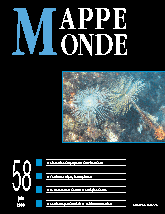
Rémy Knafou. Beach scenes in 17th century Dutch painting: the entry of the beach into the space of town-dwellers (4 fig.)
Beach scenes are a category in Dutch painting invented in the 17th century. An examination of a corpus of paintings executed during the 17th century shows that the «desire for coast» analysed by Alain Corbin appeared on the North Sea coast as early as the 17th century, with the opening of the beach to leisured residents of the nearby towns.
keywords: BEACH SCENES, HOLLAND, ORIGINS OF TOURISM, PAINTING, 17th CENTURY, URBAN LEISURE
Mireille Bruston. From baths to tourism: the enticement of water in the 1880s (3 fig.)
The monographs of the French départements by the nineteenth-century geographer Adolphe Joanne make it possible to paint a picture of tourism in France in the 1880s. Through an analysis of that corpus, this paper seeks to reveal the main trends, but also the variety of situations, from which an important observation can be made: the original link between baths and tourism.
keywords: ADOLPHE JOANNE, BATHS, FRANCE, MINERAL SPRINGS, TOURIST SITES
The development of tourism and spatial dynamics in Nepal (3 fig.)
The tourist area can be defined as a set of towns, places and sites that are the culminating points of or stopovers on itineraries in loops formed by the movement of tourists. By highlighting these loops in Nepal and the way in which they have appeared in places that give them meaning, according to the practices of the various stakeholders in tourism, it is possible to analyse the gradual structuring and dynamics of this tourist area.
keywords: HIMALAYAS, NATIONAL PARK, NEPAL, SPATIAL DYNAMICS, TOURISM, TOURIST SITE
Jean-Christophe Gay. The development of tourism in the intertropical islands (4 fig.)
Air transport has played a fundamental role in the development of tourism in the intertropical islands, by bringing the first tourists and by determining the location of hotel accommodation close to the airport. The opposition between the windward and leeward coasts is also a decisive factor. At a higher level of analysis, political boundaries are seen to influence the diffusion of tourism in the archipelagos.
keywords: AIR TRANSPORT, DIFFUSION, INTERTROPICAL CONVERGENCE ZONE, ISLAND, POLITICAL BOUNDARIES, TOURISM
Roger Brunet. The geographical lessons of the french 1999 census (3 fig.)
The 1999 population census shows the continuing trends of a population increase in the (extended) Paris region, on the coasts and in the south of France; the depopulation of the centre of the country; and a general rediffusion of settlement, which is allowing many municipalities to return to growth and is mitigating some contrasts. However, the census also reveals some new crisis points.
keywords: CENSUS, FRANCE, METROPOLISATION, POPULATION
Martine Droulers, The impact of international trade on the territory of Brazil (3 fig.)
An analysis of Brazilian statistics on foreign trade shows the changes that have occurred since the real plan and the liberalisation of trade. While the European Union and the United States stand out as Brazils leading trading partners, the share of the Mercosur countries is increasing. The distribution of trade across the territory of Brazil highlights the overwhelming dominance of the Sudeste region and particularly the state of São Paulo.
keywords: BALANCE OF TRADE, BRAZIL, FOREIGN TRADE, GLOBALISATION, MERCOSUR
Models of the Centre region in France (3 fig.)
A reasoned choice of models is used to take account of the spatial structures and dynamics of the Centre region in France, the factors that endure and the factors that change. The hypothesis of a spatial organisation of the region chiefly determined by the proximity of a major world city (Paris) and the presence of a major river (the Loire) is verified.
keywords: CENTRE REGION, GRAPHIC MODELLING, LOIRE VALLEY, PARIS, SPATIAL ORGANISATION
Frédéric Galinier. New leisure activities, new spaces: the sea bed off the coast of Languedoc-Roussillon (3 fig.)
The exploration of the sea bed is attracting a growing number of young town-dwellers. The coast off the département of Hérault, although flat and unrocky, is no exception to the rule and sub-aquatic activities are developing there. The effects are considerable on the income of some coastal municipalities, and on the environment.
keywords: COAST, DIVING, ENVIRONMENT, LEISURE, MEDITERRANEAN, SEA BED
Book reviews (Roger Brunet, Pierre Usselmann)
Mappemonde 1/00![]()
![]() Mappemonde 3/00
Mappemonde 3/00
For subscribe or buy this issue: BELIN
Last modified: June 9, 2000